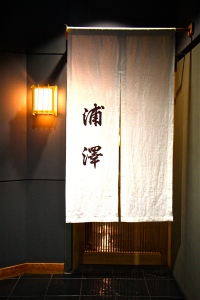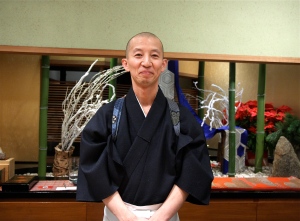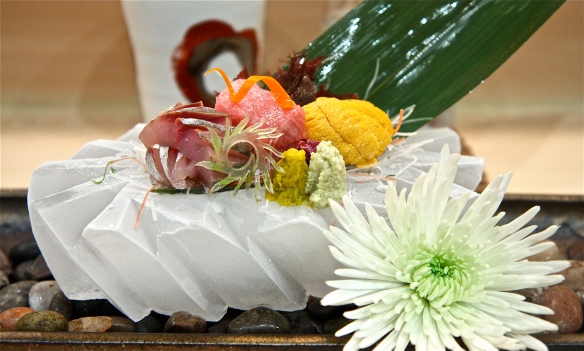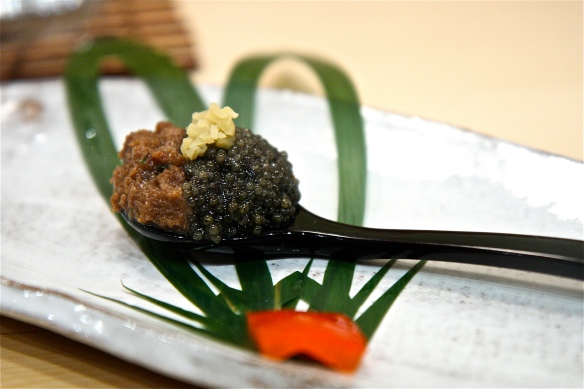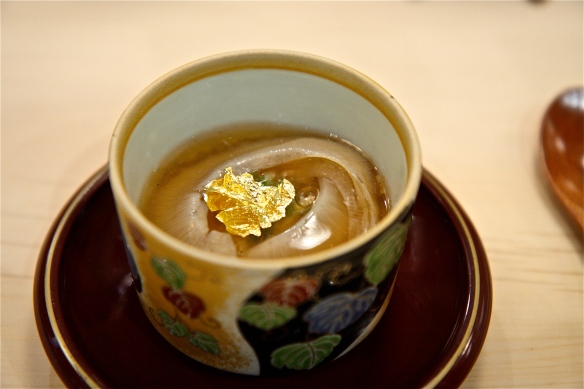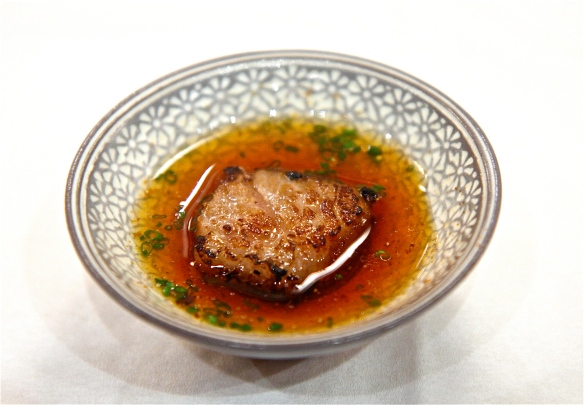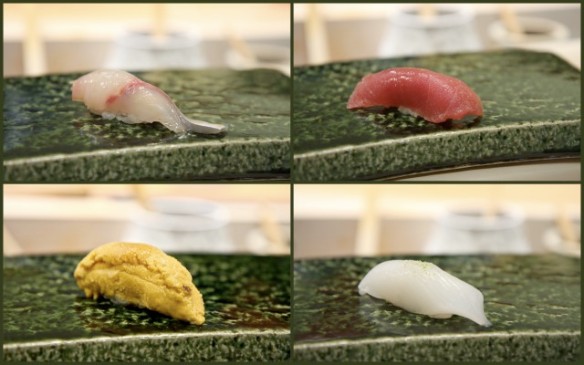The mountains, a baby pink hue of blushing spring cherry blossoms, turns a vivid green in the summer to a lively chorus of shrilling cicadas, then transforms into a stunning background of reds and yellows as the autumn maple leaves take on their fiery colors. In the dead of winter is when I find these majestic mountains in its most beautiful state, a steely landscape hushed by the deep snowfall and the valley below blanketed in pure white.
 Every year I look forward to this serene view of the Okuyugawara mountains from my private outdoor onsen, a rotenburo bath made with hinoki cypress wood that gives off a refreshing forest aroma as I soak in the healing hot springs at Tsubaki ryokan. There is nothing quite like a ryokan experience in Japan where guests travel from afar to indulge and relax in the comfort of true Japanese hospitality. Tsubaki, a traditional ryokan opened in 1978, is only an hour by express train from Tokyo and an additional 30 minutes by car along the coast line, straight past the mikan orchards that grow on the slopes of Atami and deep into the hidden mountains of Okuyugawara.
Every year I look forward to this serene view of the Okuyugawara mountains from my private outdoor onsen, a rotenburo bath made with hinoki cypress wood that gives off a refreshing forest aroma as I soak in the healing hot springs at Tsubaki ryokan. There is nothing quite like a ryokan experience in Japan where guests travel from afar to indulge and relax in the comfort of true Japanese hospitality. Tsubaki, a traditional ryokan opened in 1978, is only an hour by express train from Tokyo and an additional 30 minutes by car along the coast line, straight past the mikan orchards that grow on the slopes of Atami and deep into the hidden mountains of Okuyugawara.
 As I take that first step through the entrance of Tsubaki, I leave all of my stress and worries at the doorstep and enter into a haven of beauty and serenity. Ryokan are traditional Japanese inns where people come to rejuvenate their body in the healing waters of the local natural hot springs, rest their weary feet in the comfortable tatami rooms and nourish their souls with traditional kaiseki meals.
As I take that first step through the entrance of Tsubaki, I leave all of my stress and worries at the doorstep and enter into a haven of beauty and serenity. Ryokan are traditional Japanese inns where people come to rejuvenate their body in the healing waters of the local natural hot springs, rest their weary feet in the comfortable tatami rooms and nourish their souls with traditional kaiseki meals.
 It is quiet at Tsubaki, a good soothing silence save for the occasional soft rustle of leaves swaying in the cool wind and the gentle babble of the stream that runs below. A faint aroma slithers through the hallways, a brew of incense and freshly whisked green tea, while guests shuffle along the cobblestone paths in their yukatas to the communal bath for their first soak of the day.
It is quiet at Tsubaki, a good soothing silence save for the occasional soft rustle of leaves swaying in the cool wind and the gentle babble of the stream that runs below. A faint aroma slithers through the hallways, a brew of incense and freshly whisked green tea, while guests shuffle along the cobblestone paths in their yukatas to the communal bath for their first soak of the day.
 There are 15 rooms at Tsubaki, each tastefully decorated in wabi sabi aesthetics of simple and understated beauty with accents of ancient scrolls, beautiful ceramics and breathtaking ikebana flower arrangements. Some, like my favorite room, have an unobstructed view of the forest and the snow capped mountains, while others look over the koi pond and the zen rock gardens. The room smells like fresh straw, and I lay down on the floor, my body flat against the green tatami mats as I deeply inhale its aroma into my lungs for my first real moment of relaxation.
There are 15 rooms at Tsubaki, each tastefully decorated in wabi sabi aesthetics of simple and understated beauty with accents of ancient scrolls, beautiful ceramics and breathtaking ikebana flower arrangements. Some, like my favorite room, have an unobstructed view of the forest and the snow capped mountains, while others look over the koi pond and the zen rock gardens. The room smells like fresh straw, and I lay down on the floor, my body flat against the green tatami mats as I deeply inhale its aroma into my lungs for my first real moment of relaxation.
 Since 1978 Tsubaki has been one of the most exclusive ryokans in the country, maintaining the same level of hospitality and quality of service since its opening. There is a Japanese term called ‘ichigo ichie’ 一期一会, meaning ‘one time, one meeting’. Each new encounter, each new meeting is a unique and special moment that will never recur in one’s lifetime, and therefore, must be treated with utmost sincerity. The staff at Tsubaki live by these standards, and make every moment truly unforgettable and exceptional. For this reason, each room has an attendant, a nakai-san, that sees to your every need. One of their many important duties is to work with the chef to ensure an enjoyable kaiseki meal.
Since 1978 Tsubaki has been one of the most exclusive ryokans in the country, maintaining the same level of hospitality and quality of service since its opening. There is a Japanese term called ‘ichigo ichie’ 一期一会, meaning ‘one time, one meeting’. Each new encounter, each new meeting is a unique and special moment that will never recur in one’s lifetime, and therefore, must be treated with utmost sincerity. The staff at Tsubaki live by these standards, and make every moment truly unforgettable and exceptional. For this reason, each room has an attendant, a nakai-san, that sees to your every need. One of their many important duties is to work with the chef to ensure an enjoyable kaiseki meal.
 A stay at a traditional ryokan is as much about the food as it is about the hot springs. A full course kaiseki meal is part of the allure of this exquisite Japanese experience, and at Tsubaki, Chef Tadanori Igarashi has been creating tasting menus for its guests since its opening in 1978. Kaiseki is a type of art form that paints edible murals of seasonal landscapes on canvases of beautiful ceramics and lacquerware. It is a labor intensive process for the chefs, a precise craft that takes years to master, to be able to express such artistry and elegance.
A stay at a traditional ryokan is as much about the food as it is about the hot springs. A full course kaiseki meal is part of the allure of this exquisite Japanese experience, and at Tsubaki, Chef Tadanori Igarashi has been creating tasting menus for its guests since its opening in 1978. Kaiseki is a type of art form that paints edible murals of seasonal landscapes on canvases of beautiful ceramics and lacquerware. It is a labor intensive process for the chefs, a precise craft that takes years to master, to be able to express such artistry and elegance.
 Each plate is a study in balance and refinement, and there is a smooth flow of concepts and flavors from course to course. It is important that this elaborate meal, a ritual that when properly done takes 3-5 hours, follows a traditional formal structure in order to observe an overall sense of harmony. The menu, beautifully handwritten in Japanese calligraphy, presents the courses in its appropriate order.
Each plate is a study in balance and refinement, and there is a smooth flow of concepts and flavors from course to course. It is important that this elaborate meal, a ritual that when properly done takes 3-5 hours, follows a traditional formal structure in order to observe an overall sense of harmony. The menu, beautifully handwritten in Japanese calligraphy, presents the courses in its appropriate order.
 Sakizuke (先付): an amuse bouche
Sakizuke (先付): an amuse bouche
A shot of plum wine commences our meal, followed by the sakizuke course of kelp wrapped sayori gently curled around green bouquets of brassica with a touch of Kamo rice vinegar from Kyoto.

 Hassun (八寸): the second course, sometimes called the zensai course, sets the seasonal theme with one type of sushi and an assortment of smaller bites
Hassun (八寸): the second course, sometimes called the zensai course, sets the seasonal theme with one type of sushi and an assortment of smaller bites
This kaiseki meal at Tsubaki, enjoyed this past winter shortly after the New Year, is about celebrating new beginnings and prosperity. Slices of flash seared sea cucumber with ponzu are presented in a crane shaped ceramic bowl to symbolize longevity, with ribbons of gold and silver mizuhiki strings expressing joy. Komochikombu (herring egg coated seaweed), a caviar topped potato chip, cured karasumi bottarga made with mullet roe, a bitter orange syrup of salted cod ovaries in an aromatic bowl of carved yuzu and a cut of ayu with its roe simmered with sansho berries symbolize fertility and new life. A green fukinotou butterbur stem, simmered with peppercorns, gives me a bitter bite that I love with my glass of cold sake, to which I follow with the delicious pieces of pressed salmon matsumae sushi. This hassun course brings seasonal gifts of land and sea together on the plate for a picturesque arrangement of colors and shapes.
 Futamono (蓋物): a “lidded dish”, also referred to as wanmono, which presents a warm soup
Futamono (蓋物): a “lidded dish”, also referred to as wanmono, which presents a warm soup
A floating leaf on the surface of a pond, a green kinome pepper leaf creates a beautiful scenario in this futamono course where a white fluffy hamaguri clam shinjo infuses its bold flavors into the suimono broth. A green udo stem, crisp both in texture and in its fennel-like flavor, create a contrast against the delicately constructed temarifu, a pillowy ball of gluten with colorful decorations to resemble a traditional New Year toy called a temari.
 Mukōzuke (向付): a seasonal sashimi plate
Mukōzuke (向付): a seasonal sashimi plate
The mukozuke course presents the freshest offerings of the sea in a simple presentation so that the guests can enjoy the pure flavors of the fish. Divine cuts of fatty bluefin toro are augmented with a hint of Japanese karashi mustard and soy sauce, and meaty akagai clams of a warm orange hue are perfect with freshly grated wasabi. The final sashimi presented in the hamaguri shell-shaped ceramic, a symbol of love and harmony, is hirame wrapped in a rich coating of uni that woos with its sweetness.
 Meshimushi (飯蒸し): a steamed rice course, a special dish that is not often included in a standard kaiseki
Meshimushi (飯蒸し): a steamed rice course, a special dish that is not often included in a standard kaiseki
Kuri okowa, a steamed glutinous mochi rice dish with chestnuts and a sprinkling of black sesame salt, is another celebratory dish that the Japanese commonly prepare for festive occasions. The red hue imparted by the azuki beans is what makes this dish a symbol of happiness and joy, a standard offering at birthdays and weddings.
 Takiawase (焚合): simmered vegetables served with meat, fish or tofu
Takiawase (焚合): simmered vegetables served with meat, fish or tofu
In keeping with the traditional Kyoto style of kaiseki, this takiawase course keeps the seasonings light and subdued to appreciate the true flavors of the vegetables at their peak. Horikawa gobo, a thick spongy burdock root that is a winter standard, is stuffed with minced chicken meat and simmered in a light dashi until the vegetable has been plumped full of umami. Lightly sake braised abalone, tender and moist, is accompanied by boiled mibuna greens and a dash of yuzu rinds for aroma.
 Yakimono (焼物): broiled seasonal fish
Yakimono (焼物): broiled seasonal fish
2 delicacies that pair beautifully with cold dry sake find its way onto my plate for the first of the yakimono courses. Sweet luscious cream oozes from within the seared membranes of the fugu shirako, poisonous puffer fish sperm sacs that are particularly plump and lovely this time of year. To contrast, there is a triangular wedge of lightly seared bachiko, dried sea cucumber ovaries with a salty briny flavor that intensifies with each successive bite.
 We each get our own plate of ise ebi, a majestic Japanese spiny lobster that is arguably the most festive culinary symbol for New Year celebrations. The sweet flesh is briefly tossed in shuto, salt marinated bonito innards, then baked on a hot stone to a dramatic orchestra of sputters and sizzles as we all wait, impatiently, for our moment to pounce.
We each get our own plate of ise ebi, a majestic Japanese spiny lobster that is arguably the most festive culinary symbol for New Year celebrations. The sweet flesh is briefly tossed in shuto, salt marinated bonito innards, then baked on a hot stone to a dramatic orchestra of sputters and sizzles as we all wait, impatiently, for our moment to pounce.

 Shiizakana (進肴、強肴): also called azukebachi, is a course designed to encourage the consumption and enjoyment of sake
Shiizakana (進肴、強肴): also called azukebachi, is a course designed to encourage the consumption and enjoyment of sake
As if the 2 yakimono courses aren’t enough to encourage happy sake drinking, we get a trio of delights representing cardinal Japanese winter delicacies that make the sake flow even more freely. Suppon nikogori, a thick gelatinous soup of snapping turtle with enough collagen to equal a Botox treatment, is served in an aromatic yuzu bowl, and Matsuba crab competes with Kegani hairy crab for a stand off where both ultimately win.
 Onmono (温物): a warm braised dish, sometimes presented as a hot pot
Onmono (温物): a warm braised dish, sometimes presented as a hot pot
The onmono course, as it is one of the last courses of a kaiseki meal, is intended to aid digestion and be gentle on the nearly full stomach. A mixture of madai (tile fish), grated turnips, gingko nuts and wild mountain vegetables are simmered in a dashi broth, the result a simple and mild flavored course infused with the chef’s love.
 Gohan (御飯): a rice dish made with seasonal ingredients
Gohan (御飯): a rice dish made with seasonal ingredients
Kō no mono (香の物): seasonal pickled vegetables
Tome-wan (止椀): a miso or vegetable soup
Rice, miso soup and pickled vegetables are how a kaiseki meal typically ends, a simple combination that echoes the roots of Japanese cuisine. Chef Igarashi himself comes out to present this last course, a fuki gohan made with tangy butterbur stalks and an assortment of tsukemono (pickled vegetables) that includes yellow takuan, thinly sliced senmaizuke turnips, matsutake mushrooms infused with kombu, cucumber asazuke and red shiso calabash (hyoutan shibazuke).
In the winter, traditional Kyoto style kaiseki calls for a white miso base soup. In the summer, a more robust and intense dark red Hatcho miso. Spring and autumn incorporate both for a blended miso base. For this winter tasting menu, we slurp a nameko mushroom white miso soup- comforting, warm and delicious.
 Mizumono (水物): a seasonal dessert of fruits, confections, ice cream or cake
Mizumono (水物): a seasonal dessert of fruits, confections, ice cream or cake
First a plate of sweet juicy fruits- strawberries, blueberries, papaya and melon with a sprinkling of clear kanten crystals, followed by a Japanese dessert of koshian azuki bean paste encased in a fluffy green tea shiroan icing.
 Beautiful arrangements of seasonal ingredients with intricate garnishes, course after course, presented on attractive plates that enhance the appearance and theme of the food forms the basis of a multi-course Japanese kaiseki meal, and within the structured flow of the banquet, the chef expresses his sensitivity and style to delight his guests. It is a special experience to enjoy this in between relaxing dips in the hot springs, and to have the staff pamper you with their kindness and hospitality. For the ultimate kaiseki experience you can even have geisha accompany you for the meal. Geisha, who are highly skilled female entertainers versed in traditional Japanese song and dance, will keep the conversation lively and most importantly, as your dinner hostesses, they will ensure that your sake cup is never empty.
Beautiful arrangements of seasonal ingredients with intricate garnishes, course after course, presented on attractive plates that enhance the appearance and theme of the food forms the basis of a multi-course Japanese kaiseki meal, and within the structured flow of the banquet, the chef expresses his sensitivity and style to delight his guests. It is a special experience to enjoy this in between relaxing dips in the hot springs, and to have the staff pamper you with their kindness and hospitality. For the ultimate kaiseki experience you can even have geisha accompany you for the meal. Geisha, who are highly skilled female entertainers versed in traditional Japanese song and dance, will keep the conversation lively and most importantly, as your dinner hostesses, they will ensure that your sake cup is never empty.
Tsubaki ryokan 776 Miyakami, Yugawara machi Ashigarashimo-gun, Kanagawa prefecture Japan TEL: 0465-63-3333
Random trivia: Did you know that there can never be a married geisha? If a geisha marries, she must retire.




















